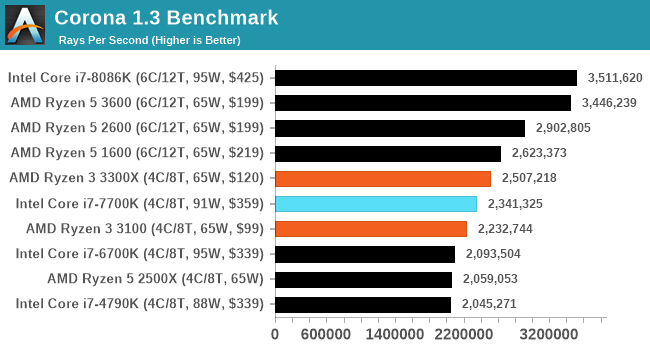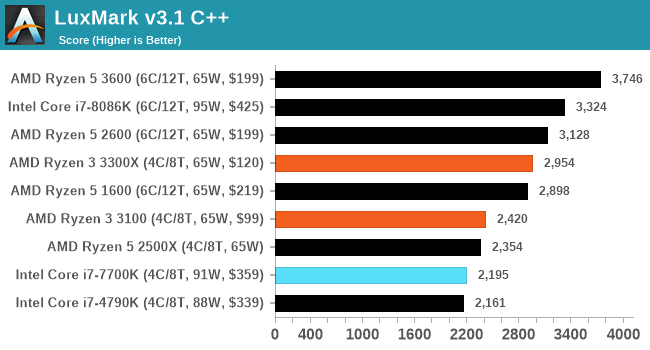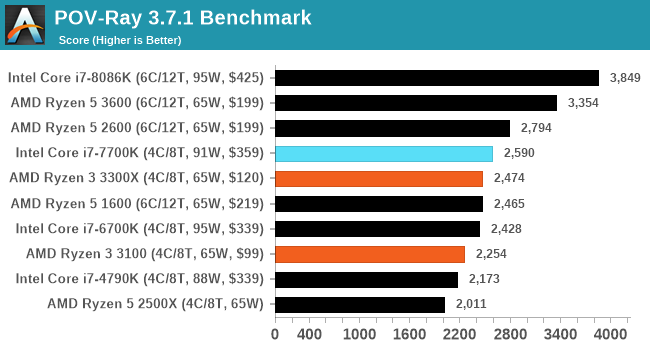The AMD Ryzen 3 3300X and 3100 CPU Review: A Budget Gaming Bonanza
by Dr. Ian Cutress on May 7, 2020 9:00 AM ESTCPU Performance: Rendering Tests
Rendering is often a key target for processor workloads, lending itself to a professional environment. It comes in different formats as well, from 3D rendering through rasterization, such as games, or by ray tracing, and invokes the ability of the software to manage meshes, textures, collisions, aliasing, physics (in animations), and discarding unnecessary work. Most renderers offer CPU code paths, while a few use GPUs and select environments use FPGAs or dedicated ASICs. For big studios however, CPUs are still the hardware of choice.
All of our benchmark results can also be found in our benchmark engine, Bench.
Corona 1.3: Performance Render
An advanced performance based renderer for software such as 3ds Max and Cinema 4D, the Corona benchmark renders a generated scene as a standard under its 1.3 software version. Normally the GUI implementation of the benchmark shows the scene being built, and allows the user to upload the result as a ‘time to complete’.
We got in contact with the developer who gave us a command line version of the benchmark that does a direct output of results. Rather than reporting time, we report the average number of rays per second across six runs, as the performance scaling of a result per unit time is typically visually easier to understand.
The Corona benchmark website can be found at https://corona-renderer.com/benchmark

LuxMark v3.1: LuxRender via Different Code Paths
As stated at the top, there are many different ways to process rendering data: CPU, GPU, Accelerator, and others. On top of that, there are many frameworks and APIs in which to program, depending on how the software will be used. LuxMark, a benchmark developed using the LuxRender engine, offers several different scenes and APIs.
In our test, we run the simple ‘Ball’ scene on both the C++ and OpenCL code paths, but in CPU mode. This scene starts with a rough render and slowly improves the quality over two minutes, giving a final result in what is essentially an average ‘kilorays per second’.

POV-Ray 3.7.1: Ray Tracing
The Persistence of Vision ray tracing engine is another well-known benchmarking tool, which was in a state of relative hibernation until AMD released its Zen processors, to which suddenly both Intel and AMD were submitting code to the main branch of the open source project. For our test, we use the built-in benchmark for all-cores, called from the command line.
POV-Ray can be downloaded from http://www.povray.org/












249 Comments
View All Comments
destorofall - Thursday, May 7, 2020 - link
you sound butthurt0ldman79 - Thursday, May 7, 2020 - link
Heaven forbid his data set of God knows how many CPU doesn't include the one you want to see...Damn, you really should demand a refund.
LMonty - Thursday, May 7, 2020 - link
You should really file a complaint, buddy. Gotta fight for your rights. ;Pjimbo2779 - Sunday, May 10, 2020 - link
What has happened to the comments section here. Can we go back to just ignoring the ignoramus'. It often means they just go away.psychobriggsy - Thursday, May 7, 2020 - link
It was mentioned that Intel didn't even send these CPUs out for review, and that they're hard to obtain because Intel isn't making many of them.However, a few more data points would be nice. I think Ian needs to set up a system test datacentre like Phoronix so the rebuilding is kept to a minimum!
twizzlebizzle22 - Thursday, May 7, 2020 - link
AMD must have sent the 7700k or specified it's use. I've noticed every review using that specific CPU. AMD aiming for the used market upgraders it seems.amrnuke - Thursday, May 7, 2020 - link
I believe that's the last Intel chip that was 4C/8T as well, right? Seems a fair comparison, I guess if AMD really think that's the market.Anyway, TechPowerUp went ahead and lined up the 3300X against a bunch of other relevant chips (https://www.techpowerup.com/review/amd-ryzen-3-330... It's 1% slower than the 3600 at 720P gaming, 16.5% slower than the 9900K at 720P gaming.
CPU tests show the 4C/8T 3300X holding up well to the 6C/6T 8600K and 9400F. It pretty well trounces the 9100F.
The 3100 beats the 9100F by 14% in CPU tests.
schujj07 - Thursday, May 7, 2020 - link
720p gaming isn't even relevant. If these were iGPU tests then sure, but even a GTX 1050 can do better than 720p gaming.supdawgwtfd - Thursday, May 7, 2020 - link
Are you stupid?To test CPU performance you run lower resolution to ensure the CPU is the bottleneck
Your comment is not relevant.
schujj07 - Saturday, May 9, 2020 - link
Hence why most review sites use 1080p. 720p benchmarking on modern hardware is akin to Quake 3 benchmarking at 640x480 resolution back in 2000. All you end up seeing are crazy high numbers that don't mean anything. We see it all the time that CPU A is faster at 720p but then slower at 1080p?